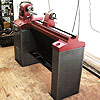I just bought my first lathe (JET 1220) and I am looking at chisel sets. The various brands and types have my head reeling. I found these on Amazon:
http://www.amazon.com/gp/product/B00723JN6U/
Does anybody have any experience with them? The set is pricey, but if I could have carbide, I think I would prefer that to high speed steel.
Cheers,
Chris




 Reply With Quote
Reply With Quote










 Laugh at least once daily, even if at yourself!
Laugh at least once daily, even if at yourself!